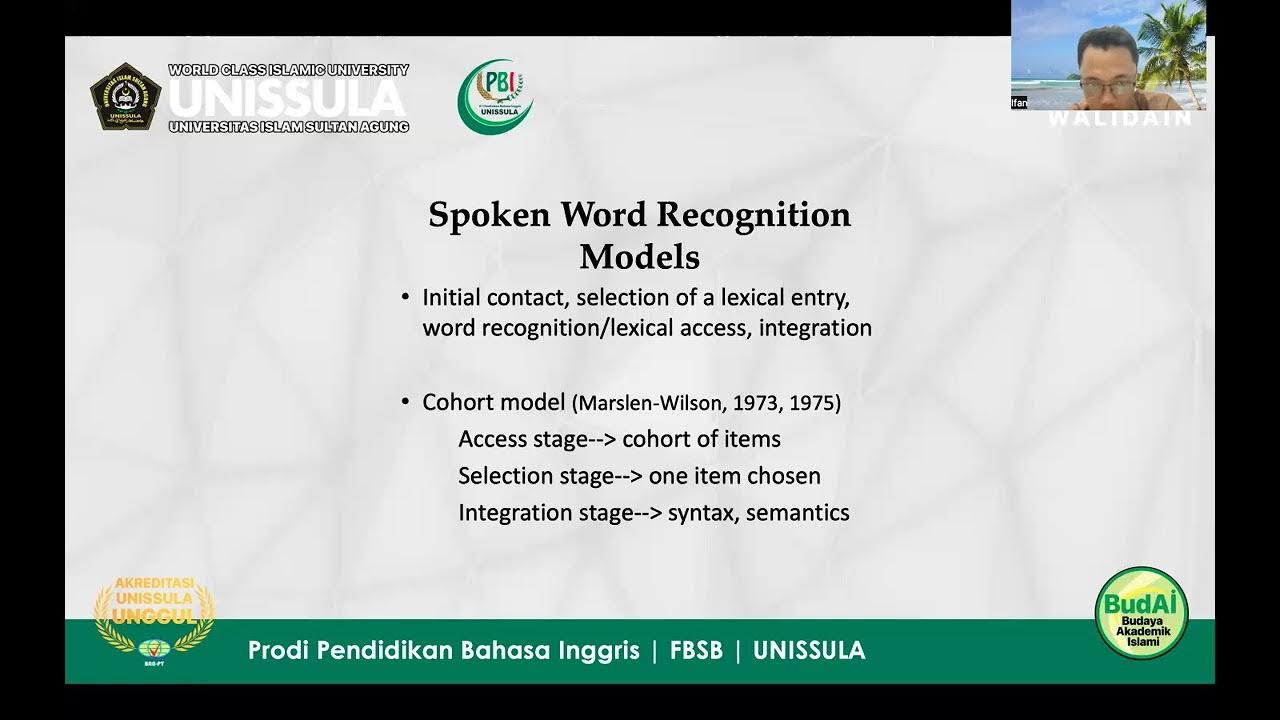Semantics in the Psycholinguistic Model - what do we mean by "semantics"?
Summary
TLDRThis video explores the semantic system, emphasizing its complexity and importance in language processing. It defines semantic memory as general knowledge of objects, meanings, and facts, distinct from episodic memory tied to specific experiences. The discussion highlights the multimodal nature of semantic knowledge, illustrating how various sensory modalities, like visual and auditory, interconnect to form a comprehensive understanding of concepts. It also differentiates between lexical semantics (word meanings) and conceptual semantics (broader knowledge), illustrating how activation spreads through related concepts during language retrieval. Overall, it sheds light on how these systems function and interact within the brain.
Takeaways
- 😀 The semantic system is a vital component of language processing, essential for understanding language impairments.
- 📚 Semantic memory refers to our general knowledge of facts, objects, and concepts, distinct from episodic memory.
- 🔍 Semantic memory includes multiple modalities: visual, tactile, auditory, and olfactory, forming an interconnected network.
- 🔄 Lexical semantics focuses on the meanings of specific words, while conceptual semantics encompasses broader knowledge and non-linguistic concepts.
- 🧠 The organization of the semantic system is based on meaning, not phonetics; similar-sounding words can have different meanings.
- ⚡ Spreading activation occurs when thinking of a word, activating related concepts and facilitating efficient language retrieval.
- 🤔 Errors in semantic processing can occur due to overlapping meanings or closely related terms, highlighting the complexity of the system.
- 🔗 The semantic system plays a significant role in effective communication and language comprehension.
- 💡 Understanding the semantic system can help in recognizing language processing errors in individuals with semantic impairments.
- 🌟 The next discussion will delve deeper into common semantic errors and their implications in language processing.
Q & A
What is the main focus of the video regarding the semantic system?
-The video primarily explores how semantic memory is structured and organized, emphasizing the multimodal nature of meaning and how concepts are interconnected.
How does semantic memory differ from episodic memory?
-Semantic memory involves general knowledge and concepts about the world, while episodic memory pertains to personal experiences and specific events.
What are some examples of modalities included in semantic memory?
-Semantic memory includes various modalities such as visual, auditory, olfactory, tactile, and action-based knowledge.
What is the concept of 'spreading activation' in semantic memory?
-Spreading activation refers to the phenomenon where thinking of or recognizing a word activates related concepts, creating a network of interconnected meanings.
What distinguishes lexical semantics from conceptual semantics?
-Lexical semantics focuses on the meanings of words and their phonological representations, while conceptual semantics involves broader, non-linguistic knowledge stored in a network of related concepts.
How are concepts organized within the semantic system?
-Concepts are organized based on meaning rather than phonetic similarity, allowing for distinct storage of words that may sound alike but have different meanings.
What kind of errors can occur when accessing semantic memory?
-Errors in semantic memory can include mixing up similar-sounding words (homophones) that have different meanings, indicating a misconnection in the retrieval process.
What role do sensory experiences play in semantic memory?
-Sensory experiences play a significant role in shaping semantic memory, as concepts often involve not just words but also tactile and taste experiences that create a richer understanding.
Can you provide an example of how a specific word activates related concepts?
-When thinking of the word 'mango,' related concepts such as 'fruit,' 'tropical,' and 'juicy' may be activated simultaneously due to their associations.
What is the significance of understanding the semantic system in language processing?
-Understanding the semantic system is crucial for comprehending how we process and produce language, and it can help address language impairments by providing insights into the organization of knowledge.
Outlines

このセクションは有料ユーザー限定です。 アクセスするには、アップグレードをお願いします。
今すぐアップグレードMindmap

このセクションは有料ユーザー限定です。 アクセスするには、アップグレードをお願いします。
今すぐアップグレードKeywords

このセクションは有料ユーザー限定です。 アクセスするには、アップグレードをお願いします。
今すぐアップグレードHighlights

このセクションは有料ユーザー限定です。 アクセスするには、アップグレードをお願いします。
今すぐアップグレードTranscripts

このセクションは有料ユーザー限定です。 アクセスするには、アップグレードをお願いします。
今すぐアップグレード5.0 / 5 (0 votes)






